fuel filter SKODA ROOMSTER 2013 1.G Owner's Manual
[x] Cancel search | Manufacturer: SKODA, Model Year: 2013, Model line: ROOMSTER, Model: SKODA ROOMSTER 2013 1.GPages: 219, PDF Size: 13.83 MB
Page 23 of 219
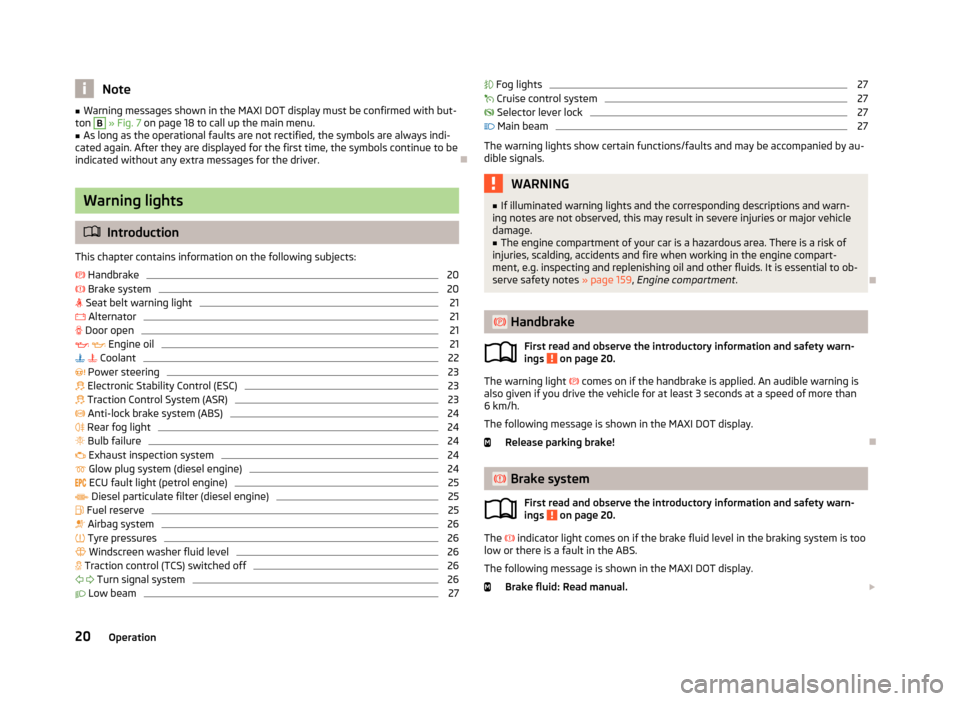
Note■Warning messages shown in the MAXI DOT display must be confirmed with but-
ton B » Fig. 7 on page 18 to call up the main menu.■
As long as the operational faults are not rectified, the symbols are always indi-
cated again. After they are displayed for the first time, the symbols continue to be
indicated without any extra messages for the driver.
Warning lights
Introduction
This chapter contains information on the following subjects:
Handbrake
20
Brake system
20
Seat belt warning light
21
Alternator
21
Door open
21
Engine oil
21
Coolant
22
Power steering
23
Electronic Stability Control (ESC)
23
Traction Control System (ASR)
23
Anti-lock brake system (ABS)
24
Rear fog light
24
Bulb failure
24
Exhaust inspection system
24
Glow plug system (diesel engine)
24
ECU fault light (petrol engine)
25
Diesel particulate filter (diesel engine)
25
Fuel reserve
25
Airbag system
26
Tyre pressures
26
Windscreen washer fluid level
26
Traction control (TCS) switched off
26
Turn signal system
26
Low beam
27 Fog lights27 Cruise control system27
Selector lever lock
27
Main beam
27
The warning lights show certain functions/faults and may be accompanied by au-
dible signals.
WARNING■ If illuminated warning lights and the corresponding descriptions and warn-
ing notes are not observed, this may result in severe injuries or major vehicle
damage.■
The engine compartment of your car is a hazardous area. There is a risk of
injuries, scalding, accidents and fire when working in the engine compart-
ment, e.g. inspecting and replenishing oil and other fluids. It is essential to ob-
serve safety notes » page 159, Engine compartment .
Handbrake
First read and observe the introductory information and safety warn-
ings
on page 20.
The warning light
comes on if the handbrake is applied. An audible warning is
also given if you drive the vehicle for at least 3 seconds at a speed of more than
6 km/h.
The following message is shown in the MAXI DOT display.
Release parking brake!
Brake system
First read and observe the introductory information and safety warn-
ings
on page 20.
The
indicator light comes on if the brake fluid level in the braking system is too
low or there is a fault in the ABS.
The following message is shown in the MAXI DOT display. Brake fluid: Read manual.
20Operation
Page 28 of 219
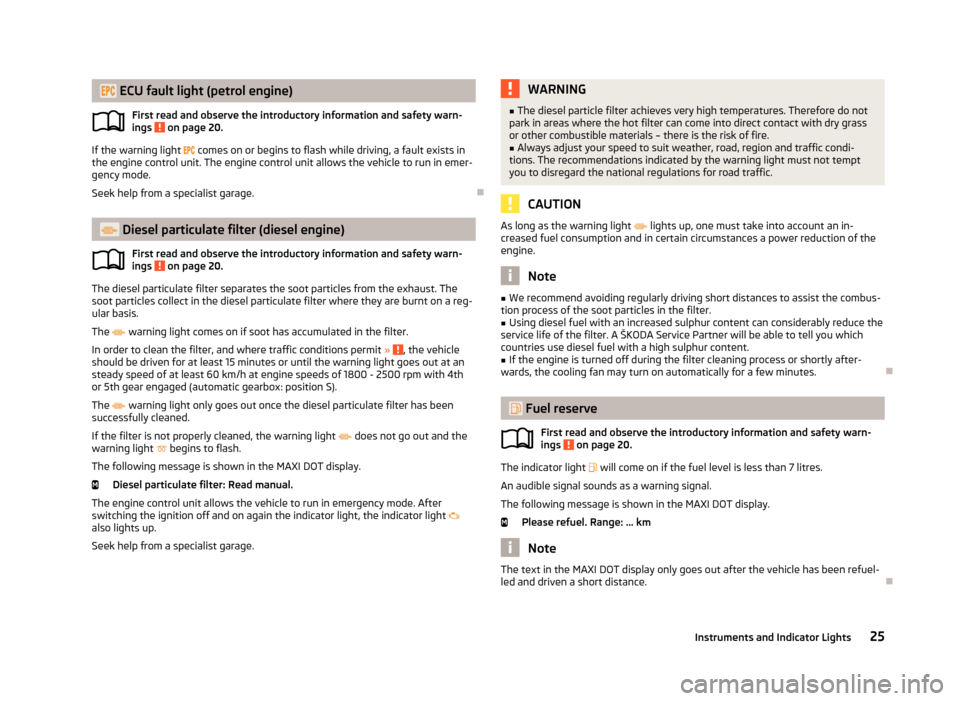
ECU fault light (petrol engine)First read and observe the introductory information and safety warn-
ings
on page 20.
If the warning light comes on or begins to flash while driving, a fault exists in
the engine control unit. The engine control unit allows the vehicle to run in emer-
gency mode.
Seek help from a specialist garage.
Diesel particulate filter (diesel engine)
First read and observe the introductory information and safety warn-ings
on page 20.
The diesel particulate filter separates the soot particles from the exhaust. The
soot particles collect in the diesel particulate filter where they are burnt on a reg-
ular basis.
The
warning light comes on if soot has accumulated in the filter.
In order to clean the filter, and where traffic conditions permit »
, the vehicle
should be driven for at least 15 minutes or until the warning light goes out at an
steady speed of at least 60 km/h at engine speeds of 1800 - 2500 rpm with 4th
or 5th gear engaged (automatic gearbox: position S).
The
warning light only goes out once the diesel particulate filter has been
successfully cleaned.
If the filter is not properly cleaned, the warning light
does not go out and the
warning light
begins to flash.
The following message is shown in the MAXI DOT display. Diesel particulate filter: Read manual.
The engine control unit allows the vehicle to run in emergency mode. After switching the ignition off and on again the indicator light, the indicator light
also lights up.
Seek help from a specialist garage.
WARNING■ The diesel particle filter achieves very high temperatures. Therefore do not
park in areas where the hot filter can come into direct contact with dry grass
or other combustible materials – there is the risk of fire.■
Always adjust your speed to suit weather, road, region and traffic condi-
tions. The recommendations indicated by the warning light must not tempt
you to disregard the national regulations for road traffic.
CAUTION
As long as the warning light lights up, one must take into account an in-
creased fuel consumption and in certain circumstances a power reduction of the
engine.
Note
■ We recommend avoiding regularly driving short distances to assist the combus-
tion process of the soot particles in the filter.■
Using diesel fuel with an increased sulphur content can considerably reduce the
service life of the filter. A ŠKODA Service Partner will be able to tell you which countries use diesel fuel with a high sulphur content.
■
If the engine is turned off during the filter cleaning process or shortly after-
wards, the cooling fan may turn on automatically for a few minutes.
Fuel reserve
First read and observe the introductory information and safety warn-ings
on page 20.
The indicator light will come on if the fuel level is less than 7 litres.
An audible signal sounds as a warning signal.
The following message is shown in the MAXI DOT display.
Please refuel. Range: ... km
Note
The text in the MAXI DOT display only goes out after the vehicle has been refuel-
led and driven a short distance.
25Instruments and Indicator Lights
Page 147 of 219
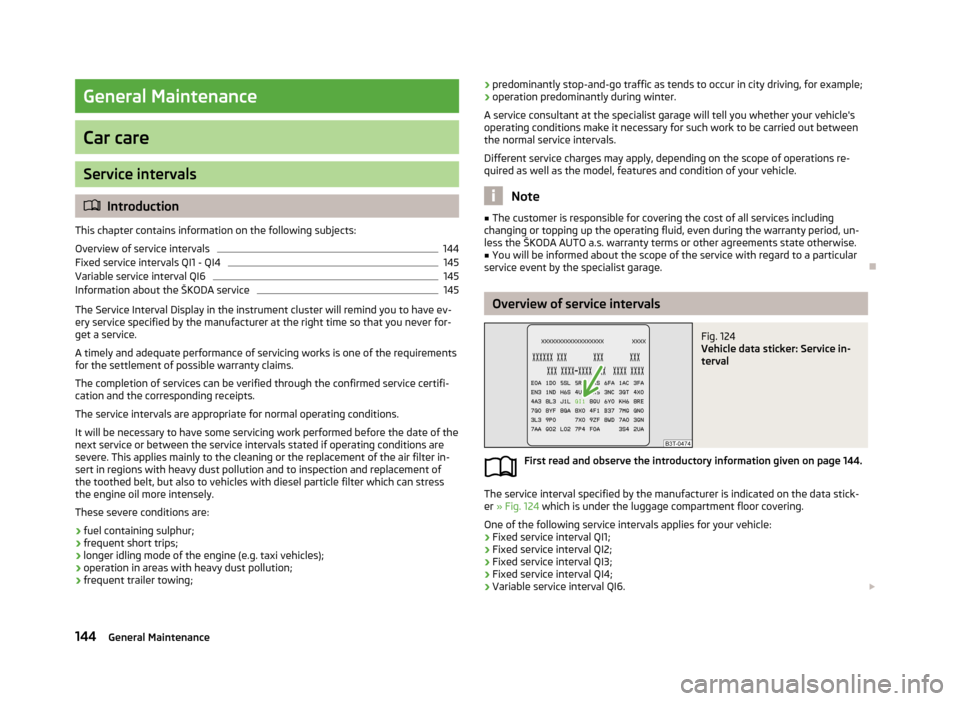
General Maintenance
Car care
Service intervals
Introduction
This chapter contains information on the following subjects:
Overview of service intervals
144
Fixed service intervals QI1 - QI4
145
Variable service interval QI6
145
Information about the ŠKODA service
145
The Service Interval Display in the instrument cluster will remind you to have ev- ery service specified by the manufacturer at the right time so that you never for- get a service.
A timely and adequate performance of servicing works is one of the requirements for the settlement of possible warranty claims.
The completion of services can be verified through the confirmed service certifi-
cation and the corresponding receipts.
The service intervals are appropriate for normal operating conditions.
It will be necessary to have some servicing work performed before the date of the next service or between the service intervals stated if operating conditions are
severe. This applies mainly to the cleaning or the replacement of the air filter in-
sert in regions with heavy dust pollution and to inspection and replacement of
the toothed belt, but also to vehicles with diesel particle filter which can stress
the engine oil more intensely.
These severe conditions are:
› fuel containing sulphur;
› frequent short trips;
› longer idling mode of the engine (e.g. taxi vehicles);
› operation in areas with heavy dust pollution;
› frequent trailer towing;
›
predominantly stop-and-go traffic as tends to occur in city driving, for example;
› operation predominantly during winter.
A service consultant at the specialist garage will tell you whether your vehicle's operating conditions make it necessary for such work to be carried out between
the normal service intervals.
Different service charges may apply, depending on the scope of operations re-
quired as well as the model, features and condition of your vehicle.
Note
■ The customer is responsible for covering the cost of all services including
changing or topping up the operating fluid, even during the warranty period, un- less the ŠKODA AUTO a.s. warranty terms or other agreements state otherwise.■
You will be informed about the scope of the service with regard to a particular
service event by the specialist garage.
Overview of service intervals
Fig. 124
Vehicle data sticker: Service in-
terval
First read and observe the introductory information given on page 144.
The service interval specified by the manufacturer is indicated on the data stick-
er » Fig. 124 which is under the luggage compartment floor covering.
One of the following service intervals applies for your vehicle: › Fixed service interval QI1;
› Fixed service interval QI2;
› Fixed service interval QI3;
› Fixed service interval QI4;
› Variable service interval QI6.
144General Maintenance
Page 162 of 219
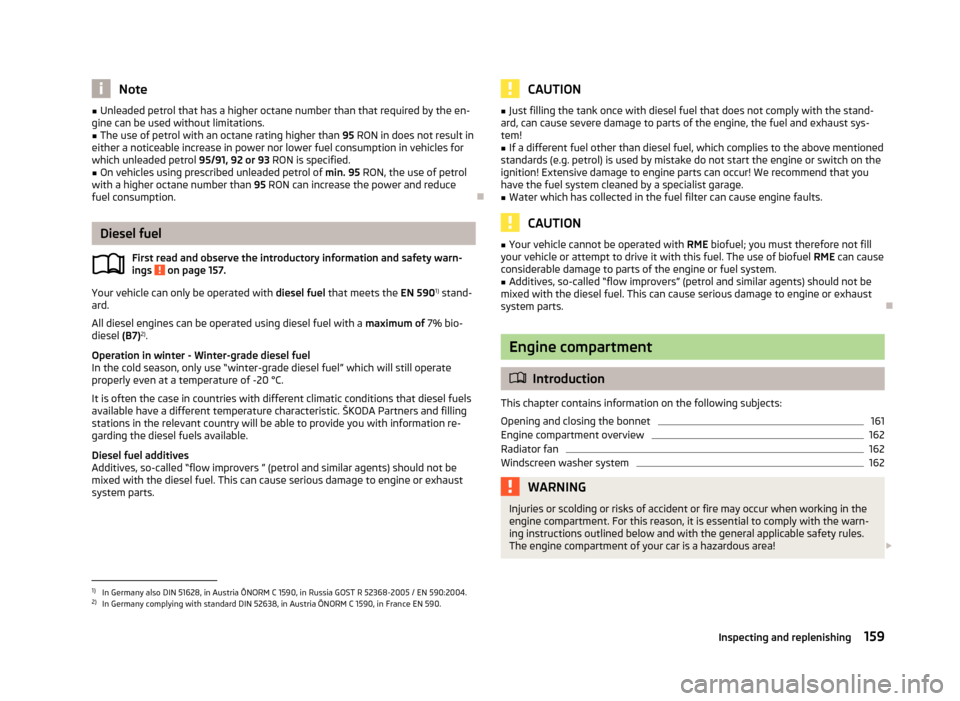
Note■Unleaded petrol that has a higher octane number than that required by the en-
gine can be used without limitations.■
The use of petrol with an octane rating higher than 95 RON in does not result in
either a noticeable increase in power nor lower fuel consumption in vehicles for
which unleaded petrol 95/91, 92 or 93 RON is specified.
■
On vehicles using prescribed unleaded petrol of min. 95 RON, the use of petrol
with a higher octane number than 95 RON can increase the power and reduce
fuel consumption.
Diesel fuel
First read and observe the introductory information and safety warn-ings
on page 157.
Your vehicle can only be operated with diesel fuel that meets the EN 5901)
stand-
ard.
All diesel engines can be operated using diesel fuel with a maximum of 7% bio-
diesel (B7)2)
.
Operation in winter - Winter-grade diesel fuel
In the cold season, only use “winter-grade diesel fuel” which will still operate
properly even at a temperature of -20 °C.
It is often the case in countries with different climatic conditions that diesel fuelsavailable have a different temperature characteristic. ŠKODA Partners and filling
stations in the relevant country will be able to provide you with information re-
garding the diesel fuels available.
Diesel fuel additives
Additives, so-called “flow improvers ” (petrol and similar agents) should not be mixed with the diesel fuel. This can cause serious damage to engine or exhaust
system parts.
CAUTION■ Just filling the tank once with diesel fuel that does not comply with the stand-
ard, can cause severe damage to parts of the engine, the fuel and exhaust sys-
tem!■
If a different fuel other than diesel fuel, which complies to the above mentioned
standards (e.g. petrol) is used by mistake do not start the engine or switch on the
ignition! Extensive damage to engine parts can occur! We recommend that you
have the fuel system cleaned by a specialist garage.
■
Water which has collected in the fuel filter can cause engine faults.
CAUTION
■ Your vehicle cannot be operated with RME biofuel; you must therefore not fill
your vehicle or attempt to drive it with this fuel. The use of biofuel RME can cause
considerable damage to parts of the engine or fuel system.■
Additives, so-called “flow improvers” (petrol and similar agents) should not be
mixed with the diesel fuel. This can cause serious damage to engine or exhaust system parts.
Engine compartment
Introduction
This chapter contains information on the following subjects:
Opening and closing the bonnet
161
Engine compartment overview
162
Radiator fan
162
Windscreen washer system
162WARNINGInjuries or scolding or risks of accident or fire may occur when working in the
engine compartment. For this reason, it is essential to comply with the warn- ing instructions outlined below and with the general applicable safety rules.
The engine compartment of your car is a hazardous area! 1)
In Germany also DIN 51628, in Austria ÖNORM C 1590, in Russia GOST R 52368-2005 / EN 590:2004.
2)
In Germany complying with standard DIN 52638, in Austria ÖNORM C 1590, in France EN 590.
159Inspecting and replenishing
Page 210 of 219
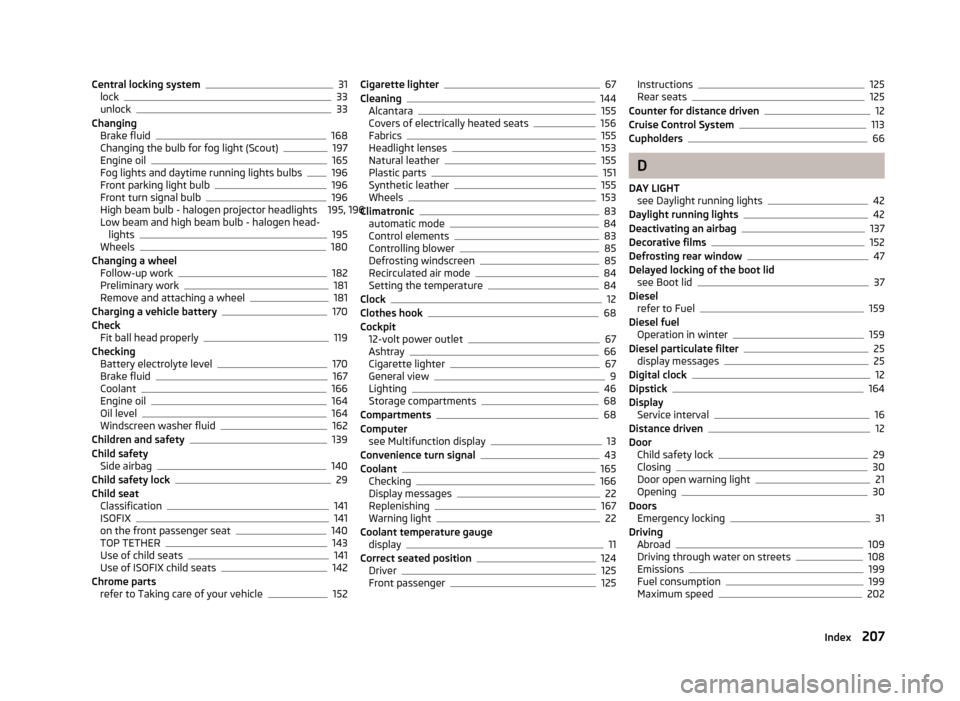
Central locking system31
lock33
unlock33
Changing Brake fluid
168
Changing the bulb for fog light (Scout)197
Engine oil165
Fog lights and daytime running lights bulbs196
Front parking light bulb196
Front turn signal bulb196
High beam bulb - halogen projector headlights 195, 196
Low beam and high beam bulb - halogen head- lights
195
Wheels180
Changing a wheel Follow-up work
182
Preliminary work181
Remove and attaching a wheel181
Charging a vehicle battery170
Check Fit ball head properly
119
Checking Battery electrolyte level
170
Brake fluid167
Coolant166
Engine oil164
Oil level164
Windscreen washer fluid162
Children and safety139
Child safety Side airbag
140
Child safety lock29
Child seat Classification
141
ISOFIX141
on the front passenger seat140
TOP TETHER143
Use of child seats141
Use of ISOFIX child seats142
Chrome parts refer to Taking care of your vehicle
152
Cigarette lighter67
Cleaning144
Alcantara155
Covers of electrically heated seats156
Fabrics155
Headlight lenses153
Natural leather155
Plastic parts151
Synthetic leather155
Wheels153
Climatronic83
automatic mode84
Control elements83
Controlling blower85
Defrosting windscreen85
Recirculated air mode84
Setting the temperature84
Clock12
Clothes hook68
Cockpit 12-volt power outlet
67
Ashtray66
Cigarette lighter67
General view9
Lighting46
Storage compartments68
Compartments68
Computer see Multifunction display
13
Convenience turn signal43
Coolant165
Checking166
Display messages22
Replenishing167
Warning light22
Coolant temperature gauge display
11
Correct seated position124
Driver125
Front passenger125
Instructions125
Rear seats125
Counter for distance driven12
Cruise Control System113
Cupholders66
D
DAY LIGHT see Daylight running lights
42
Daylight running lights42
Deactivating an airbag137
Decorative films152
Defrosting rear window47
Delayed locking of the boot lid see Boot lid
37
Diesel refer to Fuel
159
Diesel fuel Operation in winter
159
Diesel particulate filter25
display messages25
Digital clock12
Dipstick164
Display Service interval
16
Distance driven12
Door Child safety lock
29
Closing30
Door open warning light21
Opening30
Doors Emergency locking
31
Driving Abroad
109
Driving through water on streets108
Emissions199
Fuel consumption199
Maximum speed202
207Index